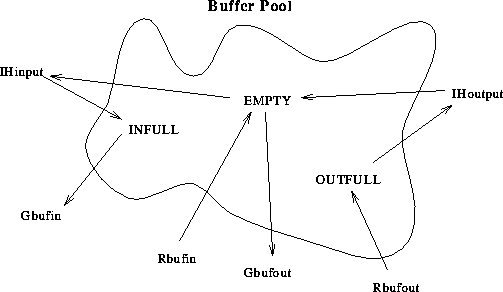- Hardware interrupts
- Software trap
- System call
However, if the processor provides a kernel-mode disable interrupts instruction, then it is possible to atomically execute a critical section. Assume that this instruction disables all hardware interrupts and that it is available only in kernel mode.
State a set of conditions which, if met, would guarantee the atomic execution of a critical section. Why is this a poor method of achieving atomicity for very, very long critical sections? Why should the disable interrupts instruction be privileged?
One solution to these problems is to maintain a buffer pool which can be used for both input and output. With this scheme, each buffer is in one of three states at any time:
- INFULL --- input buffer full and available to be returned to
the user on request.
- OUTFULL --- output buffer full and waiting to be output to
the I/O device when ready.
- EMPTY --- empty buffer available for either input or output.
There are four system calls that are invoked by the user to accomplish I/O:
- Gbufin() --- returns a pointer to the beginning of
the next full input buffer.
- Rbufin(bufptr) --- places the buffer pointed to by
bufptr back into the empty buffer pool (Hint: convert the pointer to an
index.).
- Gbufout --- returns a pointer to the beginning of an empty
buffer into which the user places data to be output.
- Rbufout(bufptr) --- places the full output buffer pointed to
by bufptr onto the output queue.
In addition, there are two interrupt handlers, one for input and one for output:
- IHinput --- called when an input operation has been
completed.
- IHoutput --- called when an output operation has been
completed.
The diagram below illustrates how a buffer can move between these different states, and the role of the system software described above.
 Write the pseudo-code for the four system routines and the two interrupt
handlers. You may assume that there are no critical section problems,
i.e., it is as if each of the routines executes with interrupts disabled.
You may assume that high-level data structures such as lists and the
appropriate manipulation routines exist, if you wish, but be sure to
indicate precisely what you are assuming.
Write the pseudo-code for the four system routines and the two interrupt
handlers. You may assume that there are no critical section problems,
i.e., it is as if each of the routines executes with interrupts disabled.
You may assume that high-level data structures such as lists and the
appropriate manipulation routines exist, if you wish, but be sure to
indicate precisely what you are assuming.